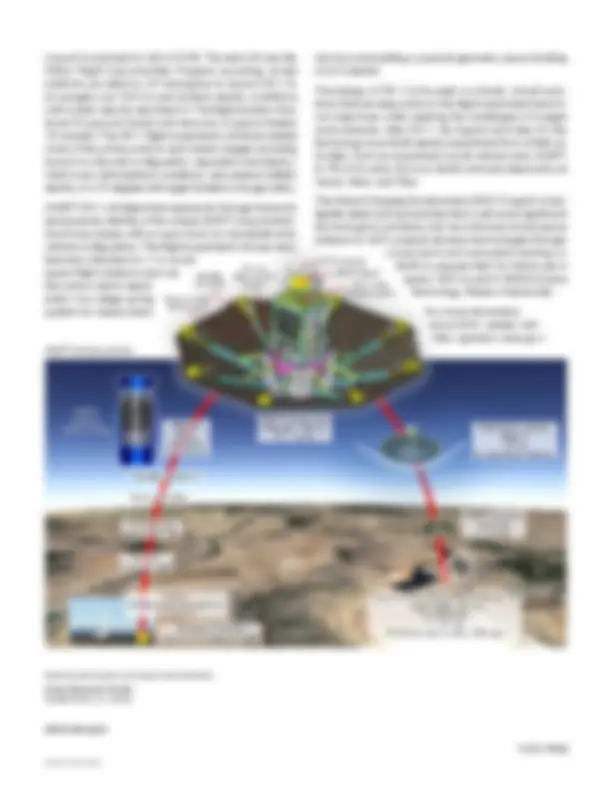



Study with the several resources on Docsity

Earn points by helping other students or get them with a premium plan


Prepare for your exams
Study with the several resources on Docsity

Earn points to download
Earn points by helping other students or get them with a premium plan
Community
Ask the community for help and clear up your study doubts
Discover the best universities in your country according to Docsity users
Free resources
Download our free guides on studying techniques, anxiety management strategies, and thesis advice from Docsity tutors
NASA's ADEPT SR-1 project aims to enhance future space missions by developing a deployable aeroshell system for planetary entry, descent, and landing. Utilizing a novel carbon fabric design, the technology ensures aerothermal protection during entry. The SR-1 flight experiment, scheduled for 2018, will test the system's in-space deployment and aerodynamic stability, advancing its technology readiness level. This initiative is under NASA's Game Changing Development Program, which seeks to revolutionize space technology.
Typology: Summaries
1 / 2

This page cannot be seen from the preview
Don't miss anything!


National Aeronautics and Space Administration
NASA’s future missions will require ever-greater mass delivery capability in order to place sci- entifically significant instrument packages on distant bodies of interest, to facilitate sample returns from them, and to enable future human exploration of Mars. The Adaptable, Deploy- able Entry and Placement Technology Sound- ing Rocket 1 (ADEPT SR-1) project is devel- oping a mechanically deployable low-ballistic coefficient aeroshell entry system to perform entry, descent and landing (EDL) functions for planetary missions. The ADEPT architecture represents a com- pletely new approach for entry vehicle design using a high-performance carbon fabric to serve as the primary drag surface of the me- chanically deployed decelerator and to pro- tect the payload from hypersonic aerothermal heating during entry. The initial system-level development of the “nano-ADEPT” architec- ture will culminate in the launch of a 0.7-m deployed diameter ADEPT sounding rocket flight experiment. The SR-1 sounding rocket flight experiment is a critical milestone in the technology maturation plan for ADEPT and will generate performance data on in-space deployment and aerodynamic stability. The ADEPT project team is advancing this de- celerator technology via systems-level testing at the 1-m diameter, or nano-ADEPT, scale. A subsonic aeroloads test (May 2015) and an arc-jet aeroheating test (Sept. 2015) have already been completed. A successful SR- flight experiment will bring the 1-m-class nano- ADEPT to technology readiness level (TRL) 5, achieving component or breadboard valida- tion in a relevant environment. Top: A flight-like ADEPT being tested in a subsonic wind tunnel. Bottom: A flight-like ADEPT skirt being tested in an arc-jet flow.
Launch is planned for fall of 2018. The test will use the NASA Flight Opportunities Program sounding rocket platform provided by UP Aerospace to launch SR-1 to an apogee over 100 km and achieve reentry conditions with a peak velocity near Mach 3. The flight duration from launch to ground impact and recovery is approximately 15 minutes. The SR-1 flight experiment will demonstrate most of the primary end-to-end mission stages including launch in a stowed configuration, separation and deploy- ment in exo-atmospheric conditions, and passive ballistic reentry of a 70-degree half-angle faceted cone geometry. ADEPT SR-1 will determine supersonic through transonic aerodynamic stability of the unique ADEPT axisymmetric, blunt body shape with an open-back (no backshell) entry vehicle configuration. The flight experiment will use many features intended for 1-m scale space flight missions such as the carbon-fabric decel- erator, two-stage spring system for deployment, and accommodating a payload geometry approximating a 3U CubeSat. The design of SR-1 is focused on simple, robust solu - tions that are responsive to the flight experiment techni- cal objectives while meeting the challenges of budget and schedule. After SR-1, the logical next step for the technology is an Earth reentry experiment from orbital ve- locities. Such an experiment would mature nano-ADEPT to TRL 6 for entry from low-Earth orbit and direct entry at Venus, Mars, and Titan. The Game Changing Development (GCD) Program inves- tigates ideas and approaches that could solve significant technological problems and revolutionize future space endeavors. GCD projects develop technologies through component and sub system testing on Earth to prepare them for future use in space. GCD is part of NASA’s Space Tech nology Mission Directorate. For more information about GCD, please visit http://gameon.nasa.gov/ ADEPT landing scenario. National Aeronautics and Space Administration Ames Research Center Moffett Field, CA 94035 www.nasa.gov NASA Facts FS-2017-03-01-ARC